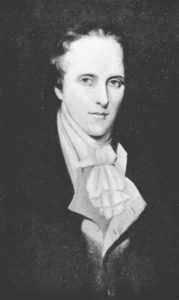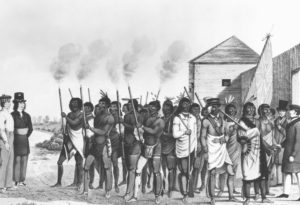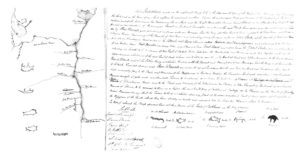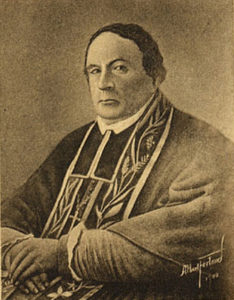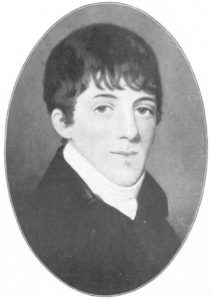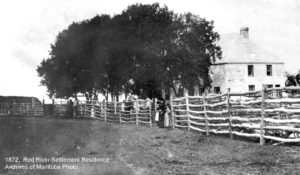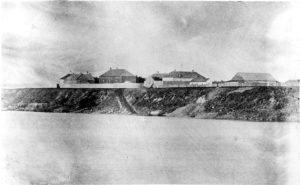By Donna Sutherland
1670 – 1870: The Fur Trade
The First European Explorers
Beginning in the 1500s, European Explorers sailed the Atlantic Ocean looking for a faster route to Asia so the people of Europe could trade their goods with the peoples of Asia.
Those early explorers did not reach Asia, but they found North America, and they discovered that the people of North America had something valuable to trade. It was animal fur, especially beaver fur.
European men, navy officers, and military officials wore top hats made of beaver fur. Those early explorers traded knives, blankets, copper pots, and beads with the First Nation’s people in exchange for their furs. This began the fur trade era.
The business of trading furs brought more and more people to what is now Canada. By the early 1700s, people had established many settlements and villages in the regions known today as the provinces of Nova Scotia and Quebec in eastern Canada. Those who settled in Quebec formed Quebec City, Montreal and Trois Rivières. Montreal became a centre for trade, especially the trading of animal fur.
Men’s Hats
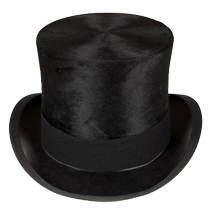
Beaver Hat
During the 1600 and 1700s, men’s hats were fashionable, including personal top hats, army officer’s hats, and Navy officer’s hats.Hat makers used the felt of the undercoat of the beaver’s pelt to make these hats waterproof. They pressed the hair into a glossy felt and worked it into several different styles.
Beaver hats became quite valuable motivating some men to will their hat to their son or friend when he died. The demand for beaver hats lasted well into the 1900s when silk replaced them.
Various styles included the Continental, the Navy, the Army, the Clerical, the Wellington, the Paris Beau, the D’Orsay, and the Regent to name a few.
La Vérendrye
French Canadian explorer, Pierre Gaultier de Varennes de la Vérendrye was born in Trois Rivères, Quebec on 17 November 1685 to Marie Boucher and René Gaultier. He became a farmer, soldier, and a small-scale fur trader.At the age of 40, he became an explorer. He was convinced the western sea was not far from the Great Lakes, so he set off into the western interior in search of it with his sons and a small group of men. They travelled on the waterways in wood framed canoes covered with birchbark that were waterproofed with balsam or pine tree sap. Canoes were light. Men carried them easily across land from one waterway to another. A crossing of land between two waterways was a portage.As those early French explorers travelled inland, they made contact with First Nation peoples. Near the Great Lakes region in modern-day Ontario, they met several groups who wore similar dress and practiced similar custom. French traders called them Saulteaux (pronounced Soto) meaning people who jump or shoot the rapids. They called them this because the people leaped and jumped across the rapids as they speared fish on the St. Mary’s River near modern day Sault Ste. Marie (Ontario). Today, Saulteaux descendants called themselves Saulteaux, Ojibway, and/or Anishinaabee. Many French men formed marital unions with Saulteaux women based on Saulteaux marriage ceremony. Their children are the Métis.As the La Vérendrye party continued on their westward trek, they arrived and settled temporarily in the region of present-day St. Clements, Manitoba. They made contact with the Cree and Assiniboine peoples who were the region’s main First Nations people at that time. The two groups participated in trade exchanges. La Vérendrye and his men built a fort in the region, which they called Fort Maurepas after the old French colony in Louisiana (New France) along the Gulf of Mexico.[2] No one knows the exact location of the old fort, but it was somewhere near the mouth of Red River where the river meets Lake Winnipeg.Other French explorers and traders soon followed making contact with First Nations peoples of the region and trading muskets (guns), cloth, blankets, beads, cooking utensils, tea, flour, sugar and other goods for native pelts and furs.
English Scots and HBC
King Charles II of England

King Charles II of England
Another group of Europeans entered North America from the north through the creation of the Hudson’s Bay Company on Hudson Bay (northern Manitoba).
King Charles II of England established the Hudson’s Bay Company on 2 May 1670 in Whitehall Palace, London, England.
- King Charles II was born in 1630
- King Charles II married Catherine Braganza 1638-1705
- King Charles II died 1685
Through a Royal Charter, King Charles II claimed all the lands that drained into Hudson Bay. He called it Rupert’s Land in honour of his cousin, Prince Rupert of Rhine. The territory he claimed covered 40% of modern-day Canada from Alberta to Quebec, and from Nunavut south into the northern United States. [4]
Journey of Fur Pelts
First Nation hunters normally trapped beaver and other animals in the winter months when the fur was long and full. After they killed an animal and removed its pelt, they gave it to the women who cleaned and tanned the hide before taking it to the trading post to trade.
At the trading post, the furs were stored in the fur loft. In the late spring, the furs were placed in bundles inside a buffalo robe and put in a press to tighten the bundle into 90-pound bales.
The bales were loaded onto boats and canoes and transported to Hudson Bay to catch the fall ship that would take them to England.
King Charles established the company after two French fur traders, Médard Chouart, Seur des Groseilliers and Pierre-Esprit Radisson, visited him and told him about the abundance of furs in North America. The King sent two ships – Eaglet and Nonsuch – to North America filled with men and trade goods.The Eaglet had to turn back to England because of a bad storm, but Nonsuch commanded by Captain Zachariah Gilliam continued on to James Bay where it’s crew over wintered and returned to England the following year with a shipload of furs traded from Cree hunters.
The Manitoba Museum houses a replica of the Nonsuch. Students can visit and walk on the deck to get a feel of the time.
First Trading Posts
Hudson’s Bay Company ships returned to the coast of James and Hudson Bay each year for two hundred years (1670 – 1870). The Company built forts along the seacoast to provide shelter for its employees as well as trading posts for First Nations peoples to trade their valuable furs for European goods, tools, weapons, and clothing. The names of the early HBC forts were:
- Rupert House ( built in 1668)
- Moose Factory ((built in 1673)
- Albany Fort (built in 1679)
- Severn Fort (built in 1680)
- York Factory (built in 1684)
- Churchill Fort/Prince of Wales Fort (built in 1714)
Hudson Bay Company Workers and First Nations People
The Hudson Bay Company hired men mostly from England, Orkney, and Scotland to work for them in North America. Men boarded ships in the ports of Gravesend, England and Stromness, Orkney and sailed across the Atlantic Ocean, through Hudson Strait into Hudson Bay. Many remained in the Bay for several years.
They met Cree hunters from the region and developed friendships as well as trade exchanges with them. Many of the men who came to Hudson Bay to work for the Hudson’s Bay Company formed marital unions with Cree women based on Cree marriage custom and ceremony. These unions were as respected and long lasting as unions based on Christian marriage practices.
The Cree did not practice Christianity. They followed their own spiritual traditions, based on Earth-based spiritual teachings that said Nature was divine, and all things in Nature are connected.
Many children were born to Cree mothers and European fathers – they shared a rich ancestry of two different continents. However, others looked down on them calling them negative and disrespectful names such as half-breed and mixed-blood.[5] Today, most descendants call themselves, Métis because they find the terms half-breed and mixed-blood to be racist and derogatory. However, the true Métis people hold a much different heritage than those of Cree/Scottish or English heritage.
Lessons from the Cree People
The Cree peoples taught European traders how to:
- survive in a harsh climate
- travel the waterways
- build birchbark canoes
- hunt and trap animals
- fish
- pick berries
- make warm clothing and dress for the cold climate
- speak the Cree language
Moving Inland
The Hudson’s Bay Company spent 100 years on James and Hudson Bay before they began to explore inland. When they finally did move inland, they met new First Nations groups to trade with and built seasonal forts or trading posts in the interior.
French traders moved inland too from the east. Often the two groups of traders fought for control of the fur trade in new regions. Both groups tried to get the First Nations people to trade with them ahead of the other.
Both groups reached the forks of the Red and Assiniboine rivers where modern-day Winnipeg sits and built forts. The main French fort was Fort Gibraltar built by The North West Company from Montreal.
Chief Peguis
As French fur traders moved westward into Manitoba, so did the Saulteaux/Ojibway peoples. One of the better-known leaders to settle in the St. Clements region was Peguis.
- Born in 1774 in Sault Ste. Marie (Ontario)
- Mother: a young Saulteaux woman – name unknown
- Father: a French Canadian fur trader – name unknown
- Moved west with his Band to Red Lake, Minnesota (USA) then to Pembina, North Dakota to trade furs with both the Hudson’s Bay Company and the North West Company
- Relocated to the forks of the Red and Assiniboine Rivers in the 1780s
- Settled on the banks of Netley Creek
- Established St. Peter’s Settlement, East Selkirk with Rev. Cockran
- Accepted the Christian name William King, his children took the surname Prince
- Died in 1864
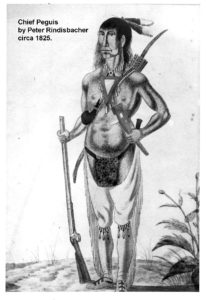
Saulteaux man, possibly Chief Peguis, Sketch by Peter Rindisbacher, Archives of Manitoba [click to enlarge]
As the Saulteaux people moved westward into Hudson’s Bay Company territory, they traded their furs with them as well as the North West Company. Many Saulteaux people settled north and northwest of the Forks.One of the larger groups (Peguis Band) settled on Netley Creek (near modern day Petersfield) before creating the settlement of St. Peter’s in East Selkirk.Link to: http://en.wikipedia.org/wiki/Ojibwe Ojibwe People at WikipediaLink to: http://www.biographi.ca/009004-119.01-e.php?BioId=38772 Peguis Dictionary of Canadian Biography, Library and Archives Canada
Lord Selkirk
The next great influx of people to arrive in the region of Manitoba came from the Highlands of Scotland. They were the Selkirk Settlers. During the 19th century, thousands of Highlanders were evicted from their homes and farms to make room for sheep.
Known as the Highland Clearances, the people had nowhere to go and no money to support them. A young and wealthy Scotsman named Thomas Douglas (Lord Selkirk) witnessed this tragic event and decided to help the destitute people.
- Born in 1771 in Kirkcudbright, Scotland
- Mother: Helen Hamilton
- Father: Dunbar Douglas
- Married Jean Wedderburn Colvile in 1807
- Became the fifth Earl of Selkirk, best known as Lord Selkirk
Lord Selkirk wanted to relocate the people to Red River so they could make a fresh start.
He bought shares in the Hudson’s Bay Company and asked the Company to grant him a piece of land suitable for the people. The Company granted him land in Rupert’s Land at the forks of the Red and Assiniboine rivers.
Hundreds of Scottish, as well as some Irish, Welsh, and English settlers, immigrated to Rupert’s Land between 1811 and 1816. They sailed on wooden sail boats that took two months to cross the Atlantic Ocean.
The sea was rough, tossing ships and people around and making many passengers seasick. Disease was common on board the ships and sometimes people died at sea. The ships sailed through Hudson Strait, to Hudson Bay and anchored at York Factory.
The people disembarked from the ships, loaded their goods and food and themselves into York boats and canoes to journey south through the various waterways, across Lake Winnipeg to Red River and up the river to the forks of the Red and Assiniboine rivers where they began their settlement. They called it Red River Settlement. It would become the city of Winnipeg.
Life in a new land
Life was difficult for the new settlers. They had to build homes for their families and barns to shelter their animals. They had to cut and haul wood to heat those homes before winter set in. They did not know the geography of the land, nor did they know how to hunt animals such as deer to feed their families.
Chief Peguis and his people came to the aid of the settlers, hunting for them, bringing them food to eat when they had none, giving them clothes and blankets to keep them warm, and snowshoes and moccasins to wear as they travelled in snow.
For the first few years, the settlers relocated to Pembina (North Dakota) for the winter near the Hudson’s Bay Company post. Peguis and his band guided them there safely.
Several Hudson’s Bay Company employees lived in Red River Settlement as well. In 1815, they built a fort on the west bank of the Red River and called it Fort Douglas.
Battle of Seven Oaks
Several French fur traders living at Fort Gibraltar did not want the new Scottish immigrants to establish their colony. They threatened them, burned their houses and destroyed their tools and crops.
Chief Peguis, and his men, tried to protect the settlers against the threats, and he even spoke to the French traders on the settlers’ behalf. However, it was not enough. The French traders continued to harass the settlers.
On 19 June 1816, men from both groups had a confrontation near a bend in the river called Seven Oaks. Tempers flared and guns were drawn. Twenty-one men died that day. Today, people call the event, the Battle of Seven Oaks.
Selkirk Treaty: Manitoba’s first Treaty
Lord Selkirk came to Red River Settlement after the battle of Seven Oaks to assist and encourage his settlers. He negotiated with French fur traders and local First Nations peoples to bring peace to the region. On 18 July 1817, Lord Selkirk signed a Treaty with five First Nations leaders: Peguis, Le Sonnant, Le Robe Noir, L’homme Noir, and Premier.
The Treaty granted land to each leader including Lord Selkirk.
Lord Selkirk stated on the Treaty that he would give one hundred pounds of tobacco each year to the First Nations leaders as payment for the use of the land.
Lord Selkirk died three years later on 8 April 1820.
Tobacco was/is a sacred medicine to First Nations people. It is offered to the Creator when praying, requesting advice, or discussing any kind of peace negotiations with other First Nations groups or with white traders and settlers.
To the First Nations leaders who signed the Treaty, tobacco symbolized a sacred bond between them and Lord Selkirk.
Red River Settlement Re-established
The Settlers re-established Red River Settlement. They built new houses and outbuildings, churches, retail outlets, and schools. They cultivated land, planted various grains and vegetables. They purchased cattle, oxen, horses, and sheep from farmers in the United States and bred those animals to expand their herds. Many settlers initially lived in Kildonan but some families also moved to other parts of the settlement.
In the years that followed many other people immigrated to the settlement. Several Swiss and German groups arrived and stayed until the early 1820s.
However, many Swiss and Germans found the winters too long and cold and most returned to their homelands or went elsewhere.
Until 1821, a multicultural group of people made up Red River Settlement:
- Cree, Assiniboine, Saulteaux/Ojibway, and Métis peoples
- French fur traders and their families
- English fur traders
- {tip Orcadian::Orcadians are the native population of the Orkney Islands, which are north of Scotland in the UK.}Orcadian{/tip} and Scottish fur traders
- Retired servants of the Hudson’s Bay Company
- Retired servants of the North West Company
- Selkirk Settlers
Christian Missionaries
Reverend Joseph-Norbert Provencher (1787-1853)
In 1818, the first Roman Catholic Missionary, Rev. Joseph-Norbert Provencher (1787-1853) arrived in Red River Settlement from Quebec.
He established a church at the forks of the two rivers. He called it St. Boniface. He performed Christian marriages between French fur traders and their Saulteaux wives, who were already married {tip à la façon du pays::in the style of the country; marriage that combined First Nations and European customs}à la façon du pays{/tip}, and baptized their children.
Link to: www.biographi.ca (Dictionary of Canadian Biography, Library and Archives Canada) for full biography of Rev. Provencher’s life and work.
Reverend John West
The first Anglican Missionary Rev. John West arrived in the settlement in 1820. He came from England on a Hudson’s Bay Company ship to York Factory and made the long trek to Red River Settlement from the north. He spent time with Chief Peguis and the Saulteaux people at Netley Creek before making his residence in the colony.He built a log church and named it St. John. He baptized many children belonging to English and Scottish fur traders and their Cree wives. He performed marriages for several European men and First Nations women who had formed marital unions many years earlier based on First Nation ceremonies.First Nations peoples were not Christians. They were very spiritual people based on an earth-based spiritual practice that taught that all in Nature is connected. Rev. John West tried to convert First Nation peoples to Christianity – some agreed, but many did not. Rev. West returned to England three years after he arrived.Link to: http://www.biographi.ca/009004-119.01-e.php?BioId=37843 “John West” at Dictionary of Canadian Biography, Library and Archives Canada on-line
The Hudson’s Bay and North West Company become one
In 1821 the two great rivalling fur trade companies, The Hudson’s Bay Company and the North West Company merged under the name The Hudson’s Bay Company. After this, the Company did not need to employ as many men. The company gave many of these men grants of land in the Red River Settlement and thus many men and their families retired and moved to the colony.
Each lot of land had river access and measured two miles in length. River frontages were measured in chains – one chain equalled 66 feet. Land lots varied from one to twelve chains equalling 25 to 200 acres, and most lots were on both sides of the Red River.
Most retirees were of English or of Scottish heritage. Their wives were primarily of Cree heritage.
Their children were of mixed heritage. These families built their homes on land in the regions of modern day St. Andrews, St. Clements, St. Pauls (Middlechurch), and St. Johns.
The men who retired from the North West Company and immigrated to Red River Settlement were mainly of French descent whose wives were mainly Saulteaux/Ojibway women. The children born to these unions were Métis – meaning to mix. These families built their homes and stables on land in the regions of St. Boniface, St. Vital, Sturgeon Creek, and Grantown.
Life of the Early Settlers
Work of early settlers
In the early days of Red River Settlement, many men of European heritage became farmers, as did some First Nations men. Women of all ethnicities toiled in the fields planting vegetables, caring for the garden, and harvesting. They did canning and preserving food for winter. They cared for the children, cooked the meals, washed and stored the dishes, sewed clothing, knitted and mended socks, made candles and soaps, and nursed the sick.
Children worked in the fields and vegetable gardens, helping their mothers. They took care of the animals.
Girls learned to sew, spin wool, knit, cook, bake, clean. Children normally attended the local school established by the church.
Foods of early settlers
- wild meat, fish and fowl
- pemmican (a paste of dried and pounded bison meat mixed with melted fat and other ingredients like berries), fish, bison, elk, venison (deer meat), moose, bear, duck, goose, wild turkey
- domestic meat and animal products
- pork, beef, lamb (a young sheep), mutton (an old sheep), eggs, milk and cream, cheese
- wild plants and animal products
- berries, wild rice, honey
- home-grown plants
- potatoes, corn, pumpkins, squash, carrots, cabbage, turnips, onions, wheat to grind flour for bread and bannock, oats for porridge
- other
- molasses, applesauce, soup, stew, baked beans
Homes of the Settlers
The early settlers and retired fur traders built their homes from log or stone. People built both types in the St. Clements region, but the log cabin was more common.Log cabins were normally square in structure measuring about six metres (19 feet) long on all sides and three metres (9 feet) high. They placed the logs on top of the other with the end of each log notched at the bottom in a sort of V shape to fit tight around the top of the log below. Builders called this a dovetail join.Their farms usually included a house, barn, chicken coop, implement shed, smokehouse, icehouse, springhouse, outhouse, and hayloft. Some of their farming equipment included: hoe, plough, harrow, sharp blade, sickle, gristmill, handsaw, hammer, axe, waterwheel, rake, auger, and chisel.
Lower Fort Garry
In 1830, Governor of the Hudson’s Bay Company Sir George Simpson ordered Lower Fort Garry to be built on the west bank of Red River near modern day Lockport.
Families travelled to Lower Fort Garry to trade furs for goods sold in the company stores. A trapper entered the office in the fur loft building with his/her furs. The clerk examined the pelts before giving a quote as to how much he felt they were worth.
Trappers and clerks often disagreed. They would barter on a fair price for both.
After an agreement was reached, the clerk recorded it in the ledger. The trapper then gathered the items he and his family needed and the clerk would subtract the price of those items from the trapper’s credit.
There was very little money exchange during that time. Sometimes the store clerk would give the trapper a token that he could take to the blacksmith or other shop if he needed to get other supplies and this would come off his credit.
If a trapper needed items and did not have furs to trade, the Company would give the trapper the goods and mark the purchase in the ledger. When the trapper had furs, he would bring them in to pay back his credit. They worked on an honour system.
Link to: http://www.pc.gc.ca/lhn-nhs/mb/fortgarry/index.aspx Lower Fort Garry National Historic Site of Canada, at Parks Canada
A Timeline
1826 – The Great Flood. Floodwaters destroyed Red River Settlement, carrying away buildings, animals, and all other things that were in its path including parts of Upper Fort Garry, a Hudson’s Bay Company fur trade post built in 1822. The gates of UFG remain at the corner of Main Street and Broadway Ave, Winnipeg. People of the settlement moved to higher ground for several weeks until the water receded.
1830 – Work began on Lower Fort Garry, the stone fort. It was built on higher ground then Upper Fort Garry to prevent it from being damaged by floodwaters.
1834 – The Hudson’s Bay Company purchased the colony of Red River from the heirs of Lord Selkirk.
1852 – The region of Red River Settlement, St. Clements and St. Andrews were devastated by another severe flood. Much of the colony was once again destroyed
1859 – The first steamboat arrived at Fort Garry, the Anson Northup, a 75-ton steamer. The steamer carried people and cargo from Minnesota (USA) to Red River Settlement. It also took people and cargo to various places on Lake Winnipeg. It docked at the mouth of Colvile Landing, Cook’s Creek until the winter of 1861/62 when she sank there.
1860 – Many people of eastern Canada begin to immigrate to Red River Settlement.
1864 – Confederation – four provinces Nova Scotia, New Brunswick, Quebec, and Ontario formed the country of Canada.
1869 – Riel rebellion. Métis leader Louis Riel and his council rebelled against the transfer of land from Rupert’s Land to Canada.
1870 – Manitoba joined Confederation to become Canada’s fifth province. The settlement of Selkirk grew outwards from the Red River on both banks. Local residents added the terms, east and west. Residents travelled between East and West Selkirk by ferryboat across Red River.
Glossary
barter: to trade by exchange of goods
Chief Peguis: Chief of the Saulteaux people of Red River Settlement
dovetail join: a joint in cabinetry and square log construction consisting of interlocking “V”-shaped cuts
half-breed: a person of European and First Nation heritage, normally English/Scottish and Cree
immigrant: people who have come to one country from another country
La Vérendrye: a French fur trader from Quebec
Métis: a person of French and Saulteaux/Ojibway heritage
musket: a gun
pelt: the skin of a fur bearing animal
portage: land between two waterways
Red River Settlement: The settlement at the junction of the Red and Assiniboine River th that was established in 1812 – the precursor of the city of Winnipeg
York boat: a one-ton wooden boat rowed by nine men that was able to carry two to four tons of goods
Sources
Botyondi, Barry Selkirk: The First Hundred Years” (Barry Potyondi, 1981)
Bumsted, J.M. Fur Trade Wars: The Founding of Western Canada (Winnipeg: Great Plains Publications: 1999)
Dempsey, A. Hugh Peguis Dictionary of Canadian Biography on-line at Library and Archives Canada
Hodge, Deborah The Kids Book of Canadian Immigration (illustrated by John Mantha) (Toronto: Kids Can Press, 2006)
Landry, Kenneth Provencher, Joseph Alfred, Rev., (Dictionary of Canadian Biography) at www.biographi.ca Library and Archives Canada
Moore, Christopher Adventurers: Hudson’s Bay Company ~ The Epic Story (Quantum Book produced for the Hudson’s Bay Company: Toronto, 2000)
Nault, Jennifer Hudson’s Bay Company (Calgary: Weigl Educational Publishers Ltd., 2007)
Parks Canada YorkBoats & Buffalo Robes: Fur Trade Life at Lower Fort Garry (1981)
Rebus, Anna Discovering Canada: Pierre de La Vérendrye (Calgary: Weigl Educational Publishers Limited, 2007)
St. Clements Heritage East Sideof the Red 1884-1984 (St. Clements: R.M. of St. Clements, 1984)
Sutherland, Donna G. Nahoway; A Distant Voice (Petersfield: White Buffalo Books: Petersfield, 2008)
Sutherland, Donna G. Peguis: A Noble Friend (St. Andrews: Chief Peguis Heritage Park Inc, 2003)
Wikipedia Fort Maurepas http://en.wikipedia.org/wiki/Fort_MaurepasWillie, Richard, A. John West Dictionary of Canadian Biography on-line

